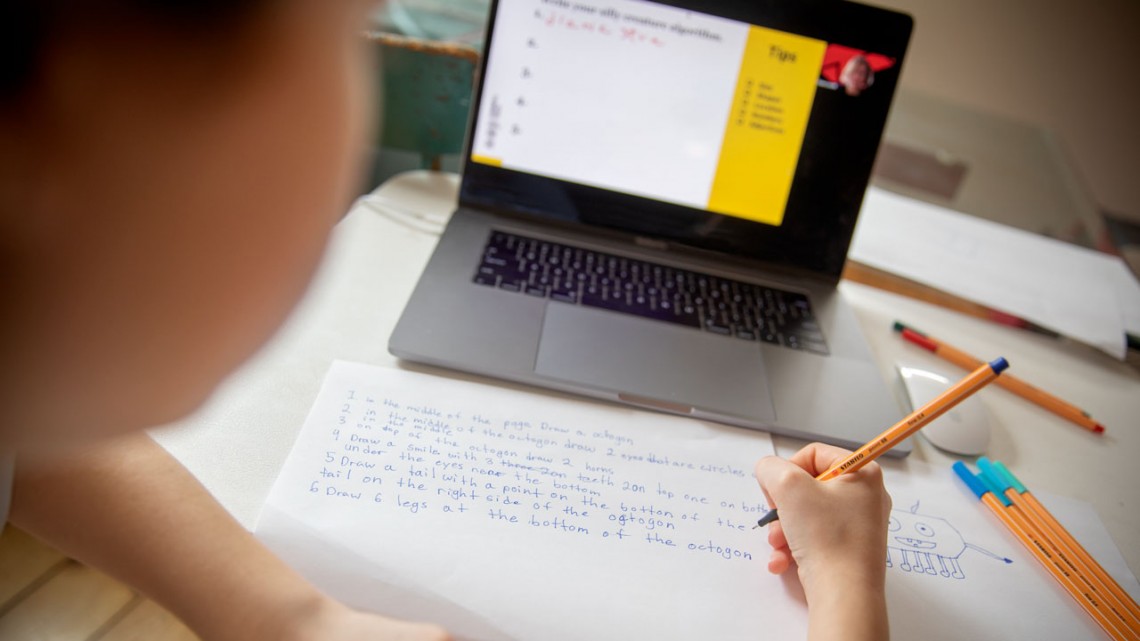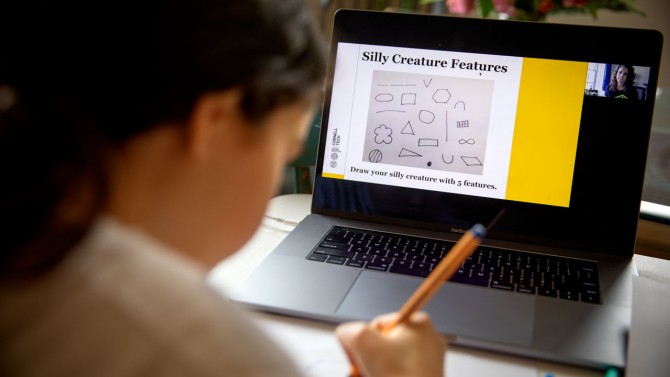
Cornell Tech’s K-12 education team has created an online lesson about algorithms and debugging, as well as a daily Twitter challenge promoting computational thinking, to help students continue learning computer science even as New York City schools are closed.
Cornell Tech provides CS lessons for kids at home
By Melanie Lefkowitz
“This is our first-ever CS at Home broadcast,” Diane Levitt, senior director of K-12 education at Cornell Tech, told a class of third-graders from Public School 86 in the Bronx on March 26 via Zoom. “Thank you for being part of our experiment. We have never done this before. So it’s good to do it with friends.”
Levitt, with other members of her K-12 team, were piloting a new virtual lesson plan intended to help New York City teachers instruct their students remotely in computational thinking. The virtual lessons – as well as daily computational challenges posted on Twitter under the handle @Breakfast_CS – are part of their efforts to continue promoting computer science education for all children, even as the city, and the world, tackle unprecedented challenges.
“There’s nothing positive about this situation,” Levitt said, “but we do have an opportunity to find out more about how students learn using an online platform. We don’t want students to stop thinking about computing.”
The day after New York City schools closed, Levitt and her team met via Zoom to brainstorm.
“How are we going to reach children and families where they are?” Levitt asked the group. “How can we leverage the digital tools we have to try to do something rigorous and joyful for students? And those two words are important to us – we’re always trying to get to the intersection of rigor and joy. We don’t want to walk away from rigor, but we definitely don’t want to walk away from joy.”
On the March 26 Zoom call, around 20 Public School 86 students were poised excitedly onscreen, siblings and parents moving in the kitchens and living rooms behind them. They chatted, sent happy face emojis and waved as their classmates’ faces popped up beside theirs.
“Computers only do exactly what we tell them to do,” Levitt told the students. “So we need to give very clear directions to the computer to tell it to do what we want it to do. To write an algorithm, we have to break a task up into many pieces, to decompose. When we decompose, we break something up into smaller pieces. Can you raise your hand if you know what decompose means?”
Virtual hands went up.
Levitt then directed the students in an algorithm of her own – giving them detailed instructions to draw what turned out to be a traffic light.
“I tried to give you clear instructions for drawing something familiar to all of us – something we see in everyday life,” she said. “So if yours looked different than this, maybe it was because my directions were not clear enough. If I gave more detailed directions, everyone’s picture would have looked exactly the same.”
In all of their lessons – formerly in-person and now virtual – Levitt’s team aims to give students tools to think computationally. That involves understanding that an algorithm is a series of instructions required to perform a task; that decomposing means breaking a task up into manageable parts; and that debugging is going back and figuring out where the mistakes were and how to fix them.
The slides used in the Zoom call will be shared with the New York City Department of Education as a resource for teachers; the team also will continue posting a daily challenge on Twitter, offering kids an “unplugged” task, such as hiding an object in their homes and drawing a map to it, or playing tic-tac-toe games in order to identify whether they can use logic to predict the outcome.
“We had the idea to digest some of the work we’ve been doing this year at P.S. 86, about how to make computational thinking accessible to children through the lens of math and English language arts, and chop it up into little bite-sized pieces,” Levitt said. “We wanted to give students a chance to have an open-ended learning experience without the constraints of time that the school day presents.”
So far, @Breakfast_CS has been retweeted by educators including a principal and superintendent, but Levitt hopes to reach families who aren’t necessarily online. “We have to figure out how to do this equitably – that’s our most urgent issue,” she said.
During the online lesson, co-led by Liz Gallo and Kelly Powers, with behind-the-scenes management by Joe Melendez, the third-graders were instructed to create their own “silly creatures.” The students wrote detailed algorithms to explain to their fellow students how to draw them, and several of them then shared their algorithms.
“So the first thing you guys are going to do is draw two big triangles,” one student said. “The next thing you’re going to do is, under those two big triangles, you’re going to do one squiggly mouth.”
When she was done, the other students held up their drawings for the others to see. They had triangle eyes, squiggly mouths, rectangle legs and circle hats.
“They all look exactly like my silly creature,” the girl said, pleased.
Media Contact
Get Cornell news delivered right to your inbox.
Subscribe


